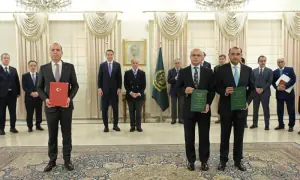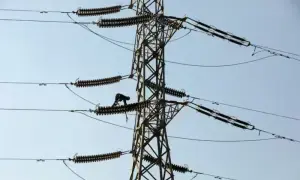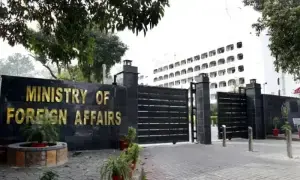WASHINGTON: China’s growing military muscle and its drive to end American predominance in the Asia-Pacific is rattling the US defence establishment.
American officials see trouble quickly accumulating on multiple fronts — Beijing’s expanding nuclear arsenal, its advances in space, cyber and missile technologies, and threats to Taiwan.
The pace at which China is moving is stunning, says Gen John Hyten, the No 2-ranking US military officer, who previously commanded US nuclear forces and oversaw Air Force space operations.
At stake is a potential shift in the global balance of power that has favoured the United States for decades. A realignment more favorable to China does not pose a direct threat to the United States but could complicate US alliances in Asia. New signs of how the Pentagon intends to deal with the China challenge may emerge in coming weeks from Biden administration policy reviews on nuclear weapons, global troop basing and overall defence strategy.
For now, officials marvel at how Beijing is marshaling the resources, technology and political will to make rapid gains, so rapid that the Biden administration is attempting to reorient all aspects of US foreign and defence policy.
The latest example of surprising speed was China’s test of a hypersonic weapon capable of partially orbiting Earth before reentering the atmosphere and gliding on a manoeuvrable path to its target. The weapon system’s design is meant to evade US missile defences, and although Beijing insisted it was testing a reusable space vehicle, not a missile, the test appeared to have startled US officials.
Gen Mark Milley, chairman of the Joint Chiefs of Staff, said the test was very close to being a Sputnik moment, akin to the 1957 launching by the Soviet Union of the world’s first space satellite, which caught the world by surprise and fed fears the United States had fallen behind technologically. What followed was a nuclear arms and space race that ultimately bankrupted the Soviet Union.
Milley and other US officials have declined to discuss details of the Chinese test, saying they are secret. He called it very concerning for the United States but added that problems posed by China’s military modernisation run far deeper.
That’s just one weapon system, he said in a Bloomberg Television interview. “The Chinese military capabilities are much greater than that. They’re expanding rapidly in space, in cyber and then in the traditional domains of land, sea and air.
On the nuclear front, private satellite imagery in recent months has revealed large additions of launch silos that suggest the possibility that China plans to increase its fleet of land-based intercontinental ballistic missiles, or ICBMs.
Hans Kristensen, a nuclear weapons expert at the Federation of American Scientists, says China appears to have about 250 ICBM silos under construction, which he says is more than 10 times the number in operation today. The US military, by comparison, has 400 active ICBM silos and 50 in reserve.
Pentagon officials and defence hawks on Capitol Hill point to China’s modernisation as a key justification for rebuilding the US nuclear arsenal, a project expected to cost more than $1 billion over 30 years, including sustainment costs.
Fiona Cunningham, an assistant professor of political science at the University of Pennsylvania and a specialist in Chinese military strategy, says a key driver of Beijing’s nuclear push is its concerns about US intentions.
“I don’t think China’s nuclear modernisation is giving it a capability to pre-emptively strike the US nuclear arsenal, and that was a really important generator of competition during the Cold War,” Cunningham said in an online forum sponsored by Georgetown University. But what it does do is to limit the effectiveness of US attempts to pre-emptively strike the Chinese arsenal.
Some analysts fear Washington will worry its way into an arms race with Beijing, frustrated at being unable to draw the Chinese into security talks. Congress also is increasingly focused on China and supports a spending boost for space and cyber operations and hypersonic technologies. There is a push, for example, to put money in the next defence budget to arm guided-missile submarines with hypersonic weapons, a plan initiated by the Trump administration.
Published in Dawn, November 2nd, 2021



































